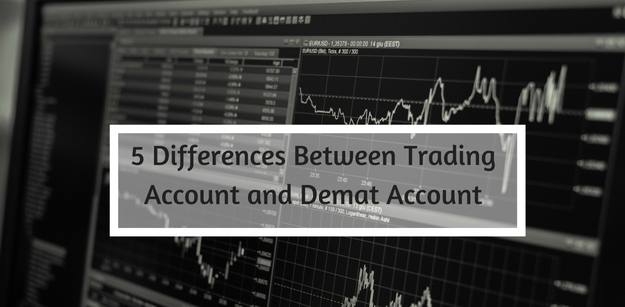Quite a few investors get confused on the nuanced difference between the trading accounts and demat account. Essentially, the trading account is a flow and the demat account is a stock. While trading account is reviewed and measured over a period of time, the demat account is viewed at a particular point of time. Here are five key differences between a demat account and a trading account.

Their essential purpose is different
Demat accounts are used to store the actual shares and other securities you buy in the market. To that extent it can be compared with your savings account in a bank. Just as a bank account holds cash on your behalf, the demat account holds shares and other securities on your behalf.
A trading account operates in the same way as your current bank account and serves as a link between your bank account and your demat account. Trading account essentially is meant for executing transactions. Thus, while a demat account works as a storage facility for your securities, a trading account is required when you want to buy or sell shares in the stock market.
The way the two accounts are operated is different
A demat account provides you the facility to retain your financial instruments in an electronic format. In the old days, shares were held as certificates in paper form. That used to be too cumbersome. Instead, the demat account allows you to hold these shares in electronic format. The trading account performs the very act of buying and selling securities. Shares are debited from your Demat account and are sold in the market through the trading account. Similarly, when you buy shares through the trading account, these shares will be credited to your demat account on T+2 date and you can hold them in electronic form.
Demat account only deals in securities that signify ownership
Demat is essentially about what you own, it could be shares, debentures, bonds or ETFs. Essentially, they are assets that you can own and the demat account signifies that ownership. If you are only trading in futures, options, and currencies, you don’t need a Demat account. Only a trading account is required to deal in these asset classes. But if you wish to invest in the stocks and shares of a company, both demat and trading accounts are a necessity. Remember, your demat account is unaffected by intraday trades and by futures & options trades. Intraday trades and F&O trades are purely contracts. They do not result in ownership and hence the demat account is not involved in any way. It is only the trading account that is involved in cases where the contracts are trade. That includes intraday trades, currency futures, currency options, stock futures, index futures, stock options and index options. They are executed through the trading account but do not impact the demat account in any way.
Costs and earnings entailed in trading accounts and demat account
Normally, there is no cost to a trading account as long as it is idle. But if you execute transactions of buy and sell, then there are transaction charges that are involved. For example, when you execute transactions the broker charges you brokerage. In addition, statutory charges like STT, GST, exchange charges, SEBI turnover taxes and stamp duty are also charged. All these add up to your total cost. Demat account entail a number of other charges. Account opening charges are normally waived but there is an annual maintenance charge (AMC) that is billed to the customer each year. This may vary between Rs.500 to Rs.800 per year. Each time you sell shares and the shares get debited to your demat account, there is a fixed charge that is payable. There is also an additional charge in case of rejection of DIS or for rejection of DRF. Additionally, when you dematerialize your physical shares or rematerialize your electronic shares, there is a separate fixed cost that is levied.
How the process flow differs and how they integrate in demat and trading account
The process flow begins with your decision to buy a share. First you need to fund your trading account by debiting your bank account. Once the trading account is funded, you can use the margin to buy shares. If the shares are not squared off on the same day, it goes into delivery. On T+2 day, the share will come into your demat account and after that you are free to sell the shares whenever you want. When you sell the shares, the reverse function operates. You can only sell shares in your trading account that you own. On the same day or by 11 am on T+1 day, you have to give the DIS to the broker for processing the demat debit. On T+1 date, the shares get debited to your demat account. On T+2 day by EOD, the credit for the sale proceeds comes into your bank account. That closes the process loop.